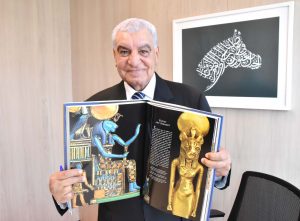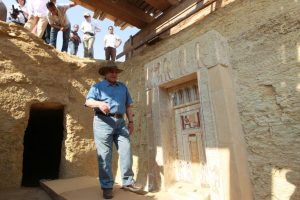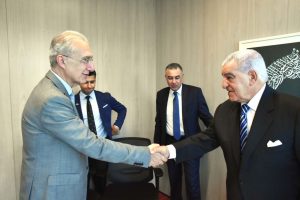São Paulo – The Egyptian archaeologist and Egyptologist Zahi Hawass is in Brazil this week for a series of lectures in São Paulo, Rio de Janeiro and Curitiba. This Monday (17) saw him visit the Arab Brazilian Chamber of Commerce, in São Paulo, where he gave an exclusive interview to ANBA. Hawass spoke on his latest work and revealed that before retiring, he hopes to find “the famed intact tomb in the Valley of the Kings” – where lies Ankhesenamun, wife of the mythic pharaoh Tutankhamun.
The researcher discussed other ongoing searches – for the tombs of Ramses VIII and Thutmose II, for instance – and he does not rule out the hypothesis that queen Nefertiti could be buried somewhere in the Valley of the Kings, the necropolis of New Kingdom pharaohs, in Luxor. He wishes to announce a major find before the end of the year. “My excavation is the biggest one in the Valley of the Kings since Howard Carter, and it’s being done by an all-Egyptian team,” he said. Carter is the British archaeologist/Egyptologist who unearthed the tomb of Tutankhamun, in 1922.
Hawass also said he wrote an opera, which is now being set to music, and regretted the fire that tore down the Rio de Janeiro National Museum, which housed an important collection of Egyptian items that was launched by former Brazilian emperor Dom Pedro II. The Egyptologist was responsible for several archaeological findings over the past decades. He chaired Egypt’s Supreme Council of Antiquities and served as minister of Antiquities. A frequent collaborator for documentary films, TV shows and magazines, he has several books out. Below are the main excerpts from the interview, divided into topics:
Recent work

“I am doing excavations in the Valley of the Kings, very important work. The Valley consists of the West Valley and the East Valley. In the West Valley, there’s the tomb of Tutankhamun’s grandfather, and in the East Valley you have the tombs of Tutankhamun and others. I started the excavation in the West Valley in mid-December 2017, searching for the tomb of Ankhesenamun [Tutankhamun’s wife].”
I am also working in the East Valley, near the tomb of Ramses VII, searching for the tomb of Ramses VIII, which is yet to be found. And I am also working near the grave of queen Hatshepsut, looking for the tomb of Thutmose II, who was her husband.”
What else does he wish to find? “I’m looking for the tomb of queen Tiye – the wife of Amenhotep III and grandmother of Tutankhamun -, and maybe Nefertiti was buried somewhere along this valley, the West Valley.”
Why search for queens in the Valley of the Kings if the Valley of the Queens is nearby? “The tombs of the 18th Dynasty queens (1,539 BC-1,292 BC) haven’t been found yet. The Valley of the Queens only came into being [as a necropolis] during the 19th Dynasty. My excavation is the biggest one in the Valley of the Kings since Howard Carter, and it’s being done by an all-Egyptian team, led by myself. We hope something important will be uncovered soon in the Valley.”
Technology
“The second project I’m working on is called ‘Scanning the Pharaohs.’ We use CT scans and DNA testing to reveal the secrets of the mummies. I even published a book by that name. I discovered the mummy of queen Hatshepsut and the family of Tutankhamun using DNA [tests]. I found out [through DNA] that Tutankhamun’s father is Akhenaton (the 18th Dynasty pharaoh who introduced a monotheistic religion in Egypt and moved the national capital to Amarna, which he built).”

“Another revelation – which I am discussing in my lectures in Brazil – is about Ramses III (1,187 BC – 1,156 BC). There was a conspiracy against him, the so-called Harem Conspiracy. His second wife, Tiya, and his son, Pentawer, tried to murder him. That is written on a papyrus, but they never [explicitly] said that the king had been killed. When I looked at the papyrus, I thought ‘This is an old man, a drunk, and many army generals wanted to kill him, yet he wasn’t killed?’ In Ancient Egypt they would never say the king had been murdered, because the king could not be killed. So I did a CT scan of the mummy of Ramses III and found out he’d been murdered. Someone came from behind him with a sharp knife and killed him. And through DNA testing I found that the mummy of an 18-year old boy that’s in the Cairo museum, which we call the Screaming Mummy, is Pentawer, the son who killed the father.”
Opera
“The last activity I’m involved with is an opera I wrote, called Tutankhamun Opera. It’s a drama about the family of Amarna, and a very famous composer in Catania [in Italy] is making the music. I’m going to Italy on January 9 [2019] to listen to the opera, as soon as the music is done. We are doing this in collaboration with the Cairo Opera. This will replicate what was done with the opera Aida, which was written by Egyptologist [Auguste] Mariette Pasha and set to music by Italian composer [Giuseppe] Verdi. I hope it will be performed at the opening of the Great Egyptian Museum [in Giza, near the Pyramids, in 2020], and on November 4, 2022, which will mark the 100th anniversary of the discovery of the tomb of Tutankhamun. The opera will be ready to be played in the main capitals of the world.”
Visit to Brazil

“This is my third visit to Brazil, but it’s my first time giving lectures here. I am aware that here in Brazil you love Egypt, because whenever I’ll go to the Valley of the Kings in my hat and my jeans [his usual outfit], all of the Brazilians want to take pictures with me.”
And how has he been welcomed? “It’s been great. [On Sunday, for the first lecture, in São Paulo] I had to take pictures with everyone – 300 people – besides giving autographs and hugs!”
National Museum fire

“I told a major newspaper that that [September 2, 2018] was a dark day for the history of Egyptian archaeology, because there never had been a fire like this in a museum, one that would destroy artifacts like those. That gave me this idea: just because other countries have Egyptian monuments, it doesn’t mean that they own them. We, as Egyptians, must check how our monuments are displayed. And if they are not being displayed in an adequate way, we must ask that they be returned. It’s like a loan. Even though they were gifts, they are really loans from Egyptian civilization. I hope that in Rio de Janeiro they can restore the monuments and build a new, fire-proof museum, because we want Egyptian artifacts to serve the purpose of education for the people of Brazil. And we are aware that Brazilians love Ancient Egypt. It’s very important that the Brazilian government learns this lesson. We all must learn and be aware of how to exhibit the monuments of any civilization in a way that will keep them safe.”
And can Egypt cooperate? “We offered, the minister of Antiquities offered to send in a delegation. They are sending in the personnel to help restore the items.”
Greatest find
“I never discuss my greatest find, because all finds are like my children. You can’t love one child more than you love another. The Valley of the Golden Mummies – they are amazing. The tombs of the builders of the Pyramids are important, because they tell the world that the builders were Egyptians and not slaves. The CT scans, the DNA tests and the discoveries that they enabled. The new developments at the Khufu (Cheops) Pyramid; the revealing of the secrets of the Sphynx. It’s all truly incredible. However, I hope to be able to end my career with the famous intact tomb of the Valley of the Kings.
Which one? “I have told you (Ankhesenamun)”. But is he close to finding it? “I hope so!”
Translated by Gabriel Pomerancblum




